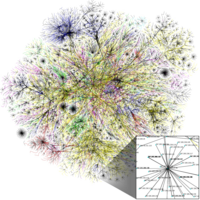
Photo from wikipedia
The massive machine-type communications (mMTC) is one of the three generic services for 5G. With the connection-based random access (CBRA) scheme, each machine-type device (MTD) establishes a connection with the… Click to show full abstract
The massive machine-type communications (mMTC) is one of the three generic services for 5G. With the connection-based random access (CBRA) scheme, each machine-type device (MTD) establishes a connection with the base station (BS) prior to its data transmission. Due to the explosive growth of the number of MTDs, many MTDs would establish connections with the BS, which necessitates the study on how to efficiently manage the massive connections with MTDs. To address this issue, in this article, we propose a unified utility-based analytical framework for the optimal connection management of mMTC in 5G networks, where the signaling overhead for connection establishment, access delay, and the connection resource utilization ratio is included. Specifically, we first derive key performance metrics, i.e., the mean time length of each connection and resource utilization ratio, as functions of traffic input rate and inactivity timer. By further considering the signaling overheads and access delay of each MTD, the network utility is formulated and maximized by optimally choosing the inactivity timer. We then present a detailed discussion on the effect of system parameters on the optimal inactivity timer and the corresponding maximum network utility. Finally, we extend the analytical framework to the scenario in which the CBRA scheme coexists with the packet-based random access scheme, i.e., transmitting packets in the random access channel without connection establishment. The critical threshold in terms of the traffic input rate is characterized, which sheds important light on the access scheme selection issue.
Journal Title: IEEE Internet of Things Journal
Year Published: 2021
Link to full text (if available)
Share on Social Media: Sign Up to like & get
recommendations!